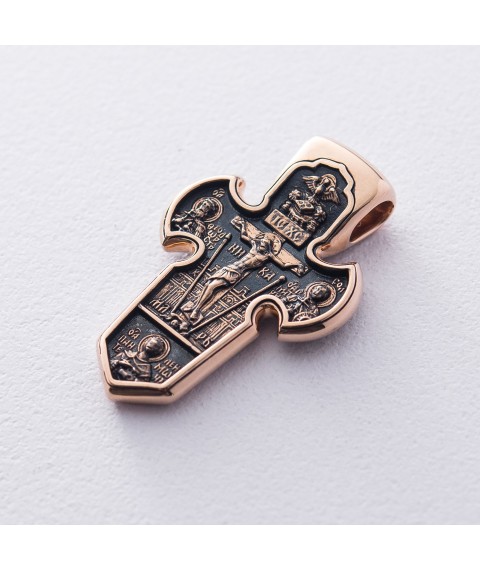Orthodox cross "Crucifixion. Archangel Michael" Metal: red gold 585"
Average weight: 15.0 g
Height (with eyelet): 3.9 cm
Cross width: 2.4 cm
Ear dimensions: 0.7 x 0.4 cm
The cross is made in the shape of a sword, which has been a symbol of spiritual struggle since biblical times. Angels and the Apostle Peter appear in the Holy Scriptures with swords in their hands. The Lord Himself says about Himself: “I did not come to bring peace, but a sword.” In Rus', the sword was traditionally identified with the cross, and was often directly used instead of it. The icon “Nicholas of Mozhaisk”, on which the saint holds a naked sword, is widely revered.
The central image of the Military Cross is the Crucifixion. On both sides of Christ are depicted the instruments of His passion: a cane with a sponge and a spear. Behind is the Jerusalem wall, a sign that the Lord was crucified outside the city walls. But at the same time, the wall also marks the Heavenly Jerusalem, the path to which was opened for humanity through Golgotha: “MLRB”, “The Place of the Skull of Paradise Was” - is written at its base.
Under the cross of Christ is the skull of Adam. Above is Etymasia, the image of the Throne, which Christ prepared for Himself through suffering and on which He will sit at the Second Coming for the Last Judgment.
On both sides of the Crucifixion there are images of the warrior-martyrs Theodore Stratelates, who was beheaded under the emperor Licinius ca. 319, and Demetrius of Thessalonica, gored by spears under Emperor Maximilian ca. 306.
At the bottom of the Military Cross there is an image of the Great Martyr. and the healer Panteleimon, a holy unmercenary physician, beheaded in 305, who was revered not only as a healer of wounds, but also as an assistant on the battlefield.
The reverse of the Military Cross opens with the majestic figure of Archangel Michael, the Archangel, that is, the supreme military leader of the Heavenly Host. His name means “Who is God?”, as he is the most powerful and formidable enemy of evil. He was the first to take up arms against Dennitsa when he rebelled against God, cast him out of Heaven and never ceases to fight his dark army. On the head of the Archangel there are ribbons called toroki (or rumors). They symbolize sensitive hearing and attention to God.
Like a military banner in invisible warfare, the Image of the Savior Not Made by Hands is placed at the top of the cross. According to Tradition, it was miraculously imprinted on a piece of canvas with which the Lord wiped his face after washing.
On both sides of the Archangel Michael, under the banner of Saint Ubrus, stand two more warriors of the squad of Christ: the great martyr. Theodore Tyrone (recruit, Greek), who suffered in 306 in the city of Anasia, and martyr. John the Warrior, tortured under Julian the Apostate in the 4th century. At the base of the Military Cross is a prayer appeal from the Canon, written in the 14th century by the holy monk Gregory of Sinaite: “Life-Giving Cross, give me strength and victory.” This is the prayer of a warrior who rebelled against evil with love for his neighbor, faith in God and hope for the constant help of His Heavenly Host.
* Attention. Product description can be obtained by machine translation.

